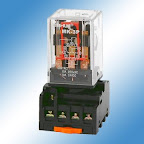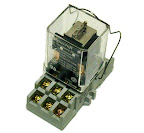In Process Control applications, it is vital to connect control systems, such as PLC’s, to the real world.
Even though PLC systems were introduced to eliminate relays, we still can’t live without them! The traditional socket mounted, electromechanical relay, often used in designs that are 30 to 40 years old, is still a highly effective solution to load-switching problems in industrial and commercial applications.
Top 10 reasons to use a Relay in a Process Control application:
- High current contacts - By using a relay interfaced to a PLC output, you now have the ability to switch on and off much higher current loads (typically 10Amps for a small plug-in relay) than by just using the PLC output alone.
- Multiple poles – Relays give your PLC the ability to switch multiple loads simultaneously. If you try this with just PLC outputs, you will need multiple individual PLC outputs to do the same job, plus programs will need modifications.
- Low replacement cost – Plug-in relays are a lot cheaper to replace than a PLC output module. If a relay contact “welds” then all that is required to fix the problem is to pull out the relay and replace it.
- Less downtime of Process Automation – It seems strange to say this, but through experience, you will find that it is quicker to pull out a suspect relay and replace it than it is to: (a) Find a spare Output Module, (b)Get authorization to shut down the Process, (c) Get maintenance to lockout all energy to the panel (d) Get maintenance personnel to replace suspect Output Module, (e) Get maintenance to energize the PLC panel and all other associated equipment, (f) Hunt down the Process operators, who went for a coffee break, (g) Get the Operators to reset the Process to a starting point, (h) Restart the Process Automation, and hope everything runs okay! On a time scale, it would take about 20 to 30 minutes to get the relay replaced, but the harsh reality is, replacing a suspect PLC Output Module could take anywhere from 1 hour to 8 hours!
- Simple control of loads – Relays are ideal for switching loads such as Lamps, motors, heaters, solenoids, pumps, etc. To use a PLC output, means to consciously design for these items during the initial design phase. Ask questions such as, what is the maximum current of the load? What is the voltage range required? Is the load inductive? Can the PLC Output be sink, source or volt free contact?
- Normally closed contacts – Ah, I hear you say, “So what!” Normally closed contacts can be a big deal in any Process Control System. When the relay is de-energized, the relay contacts are closed, allowing a circuit to be made. Now, a PLC Output is normally open (unless you use a form C relay output module). PLC digital Output Modules generally fall into a small number of categories such as Solid state A.C or D.C. and Relays. A typical application is an Interlock signal that is used between to Process Control systems. If the requirement for the Interlock is that it will be ON when de-energized, then your safest solution is the humble plug-in relay.
- No leakage current through contacts – Solid state relays and some PLC Output Modules have a small “leakage current” this is only a minute source, but can show up a source of problems during commissioning a Process Control system. Leakage current can cause strange results in a system such as Beacons on Control Panels flashing for no reason.
- Manual override ability – Some relays have a small lever that can be pushed in to manually operate the contacts. This gives you the ability to test connected circuits even when the Process Automation PLC system is off!
- Lower maintenance costs – One relay is cheaper to replace, than a whole PLC Output Module.
- Many different styles of relay help ease design issues – Relays come in many shapes and sizes to help implement an Engineers design. There are plug-in styles with an octal base, plug-in styles with flat pins, Din mounted, terminal block mounted, PC board mounted, Built-in LED indicators, Timer delay types, pulse expander types, relays that detect and operate on speed, built-in suppression of spikes and Built-in diodes for D.C. coils.



